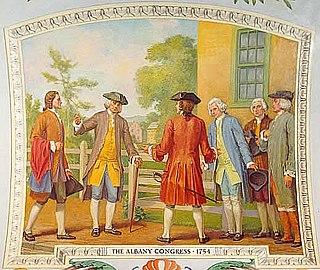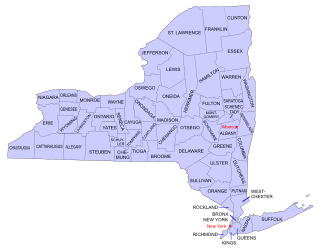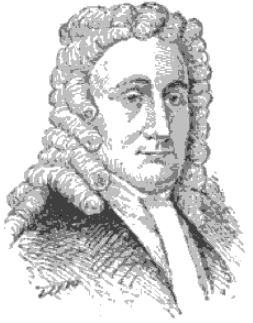
The Albany Congress, also known as the Albany Convention of 1754, was a meeting of representatives sent by the legislatures of seven of the British colonies in British America: Connecticut, Maryland, Massachusetts, New Hampshire, New York, Pennsylvania, and Rhode Island. Those not in attendance included Newfoundland, Nova Scotia, New Jersey, Virginia, Georgia, North Carolina, and South Carolina. Representatives met daily at the City Hall in Albany, New York, from June 19 to July 11, 1754, to discuss better relations with the Native American tribes and common defensive measures against the French threat from Canada in the opening stage of the French and Indian War, the North American front of the Seven Years' War between Great Britain and France.

Thomas Dongan, 2nd Earl of Limerick, was a member of the Irish Parliament, Royalist military officer during the English Civil War, and Governor of the Province of New York. He is noted for having called the first representative legislature in New York, and for granting the province's Charter of Liberties. His negotiations and subsequent alliance with the Iroquois Indian Confederacy brought a lasting security from the French and their hostile Indian allies.

Gloucester County, New York is a former county in New York that became part of the state of Vermont. It was a part of Albany County in the Province of New York until 1770 and was lost to Vermont in 1777. At that time, Vermont was holding itself out as the Republic of Vermont and did not become a state until 1791.

Jacob Leisler was a German-born colonist who served as a politician in the Province of New York. He gained wealth in New Amsterdam in the fur trade and tobacco business. In what became known as Leisler's Rebellion following the English Revolution of 1688, he took control of the city, and ultimately the entire province, from appointees of deposed King James II, in the name of the Protestant accession of William III and Mary II.

Leisler's Rebellion was an uprising in late-17th century colonial New York in which German American merchant and militia captain Jacob Leisler seized control of the southern portion of the colony and ruled it from 1689 to 1691. The uprising took place in the aftermath of England's Glorious Revolution and the 1689 Boston revolt in the Dominion of New England, which had included New York. The rebellion reflected colonial resentment against the policies of deposed King James II.

There are and have been several movements regarding secession from the U.S. state of New York. Only one of them – the state of Vermont – succeeded. Among the unsuccessful ones, the most prominent included the proposed state of Long Island, consisting of everything on the island outside New York City; a state called Niagara, the western counties of New York state; the northern counties of New York state called Upstate New York; making the city of New York a state; a proposal for a new Peconic County on eastern Long Island; and for the borough of Staten Island to secede from New York City.

Richard Coote, 1st Earl of Bellomont, known as The Lord Coote between 1683–89, was an Irish nobleman and colonial administrator who represented Droitwich in the English Parliament from 1688 to 1695. He was a prominent Williamite, supporting William III and Mary II during the Glorious Revolution.
Richard Ingoldesby was a British army officer and lieutenant governor of both New Jersey and New York. He became the acting governor for the two colonies from May 1709 to April 1710.

The Schenectady massacre was an attack against the colonial settlement of Schenectady in the English Province of New York on February 8, 1690. A raiding party of 114 French soldiers and militiamen, accompanied by 96 allied Mohawk and Algonquin warriors, attacked the unguarded community, destroying most of the homes, and killing or capturing most of its inhabitants. Sixty residents were killed, including 11 Black slaves. About 60 residents were spared, including 20 Mohawk.

Gerardus Willemse Beekman was a wealthy physician, land owner, and colonial governor of the Province of New York.
The Dongan Charter is the 1686 document incorporating Albany, New York, as a city. Albany's charter was issued by Governor Thomas Dongan of the Province of New York, a few months after Governor Dongan issued a similarly worded, but less detailed charter for the city of New York. The city of Albany was created three years after Albany County. The charter is the oldest existing city charter still in force in the United States. According to Stefan Bielinski, former senior historian of the New York State Museum, the charter is also "arguably the longest-running instrument of municipal government in the Western Hemisphere." In 1936 the United States Congress commemorated the charter's 250th anniversary by minting a half dollar coin.

The 1689 Boston revolt was a popular uprising on April 18, 1689 against the rule of Sir Edmund Andros, the governor of the Dominion of New England. A well-organized "mob" of provincial militia and citizens formed in the town of Boston, the capital of the dominion, and arrested dominion officials. Members of the Church of England were also taken into custody if they were believed to sympathize with the administration of the dominion. Neither faction sustained casualties during the revolt. Leaders of the former Massachusetts Bay Colony then reclaimed control of the government. In other colonies, members of governments displaced by the dominion were returned to power.
The history of Albany, New York from 1664 to 1784 begins with the English takeover of New Netherland and ends with the ratification of the Treaty of Paris by the Congress of the Confederation in 1784, ending the Revolutionary War.
Godefridus Dellius was a clergyman of the Dutch Reformed Church active in and around Albany, New York during the late 17th century and up to 1699. He also served as a missionary to the Mohawk people in what the English claimed as the Province of New York.
Nicholas van Rensselaer was a Reformed Dutch Church clergyman, and one time director of the Manor of Rensselaerwyck.

Jan Jansen Bleecker was a colonial era merchant and political figure who served as Mayor of Albany, New York.

The Jacob Leisler Monument is a bronze sculpture created by American artist Solon Borglum and located in the city of New Rochelle, in Westchester County, New York. The monument was erected by the Huguenot Chapter of the Daughters of the American Revolution, and the Huguenot Association of New Rochelle to the memory of Jacob Leisler, 17th-century advocate of the Huguenot settlers and said to be the first chief executive of the province of New York to draw his power directly from the people. The unveiling of the statue on June 24, 1913, was the principal event in the celebration of the 250th anniversary of the founding of New Rochelle. The monument, cast by the Roman Bronze Works, is the only existing statue of Leisler.
Dirck Wesselse Ten Broeck, also known as Dirck Wessels, was a prominent early settler of Albany, New York. He is known as "the progenitor of the Albany family of Ten Broecks."
Jacob Milborne was an American clerk living in the Province of New York who was an ally, secretary and son-in-law of the rebel Jacob Leisler, served briefly as Attorney General of the province, and was executed for his part in Leisler's Rebellion.
Abraham Gouverneur was a Dutch born colonial American merchant and Leislerian politician who served as the Speaker of the New York General Assembly.










